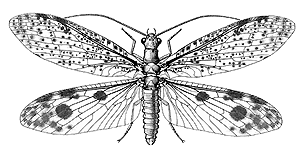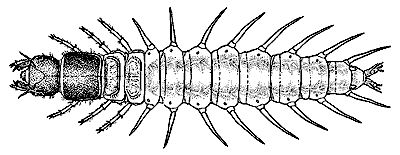|
Megaloptera:
dobsonflies and alderflies
Characteristics
This is
a very small order of Australian insects commonly known as alderflies
and dobsonflies. They are medium to large sized insects with a wingspan
ranging from 20 to 100 millimetres. Alderflies and dobsonflies can
be recognised by the following features:

Archichauliodes
species (CORYDALIDAE)
|
|
- Long, soft,
flexible bodies, usually dark coloured
- 2 pairs of
membranous
wings of similar size, often bearing dark patches.
- At rest the
wings are held roof-like over the body
- Mandibulate
mouthparts
- Long filiform
antennae which taper towards the end
CORYDALIDAE
is a widespread family of dobsonflies and well represented in Australia.
Archichauliodes species are inhabitants of cold-water streams
and can be found from southern Australia to north Queensland. Adults
of this species can usually be recognised as they have 4 or 5 large
spots on their hind wings in addition to many smaller spots towards
the edges of the wing.
The larvae
of alderflies and dobsonflies are aquatic, appear caterpillar-like
and possess gills along the sides of their abdomens.

Archichauliodes species (CORYDALIDAE)
|
Members of Megaloptera
are sometimes confused with lacewings
(Neuroptera) and stoneflies
(Plecoptera).
Alderflies and dobsonflies can be distinguished from lacewings by
the absence of terminal branching wing veins and from the later
as stoneflies possess abdominal cerci
and hind wings that are larger and broader than their forewings.
Life Cycle
All species
have aquatic larvae
and mating occurs on the vegetation close to freshwater streams.
Female alderflies and dobsonflies may lay up to 3000 eggs on rocks
or debris close to the stream but not in the water. When the larvae
hatch they enter the water and live a permanently aquatic life until
they are ready to pupate.
At this stage the larvae
move out of the water into the adjacent leaf litter or soil where
they pupate
for several weeks. The complete
life cycle may take only one year in warmer areas or
up to 5 in colder climates.
Feeding
The adults
are most active at dusk and during the night but do not appear to
feed. The larvae
however are active predators
of other aquatic invertebrates and have strong mandibles
with which to grasp their prey.
Habitat
Alderflies
and dobsonflies are not strong fliers and are therefore found close
by freshwater streams due to their aquatic larvae.
The adults can often be found on the vegetation along side streams
and are sometimes attracted to lights at night. The larvae
can be found on the bottom of clear, cool freshwater streams. Megalopteran
species are more common along the eastern side of Australia from
Cape York to Tasmania with only one species occurring in the south
west of Western Australia.
|


